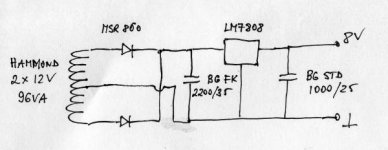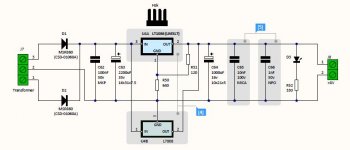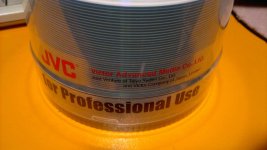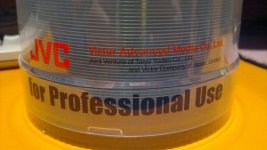Here's the PS schematic. I tried some popular regulators (LM317, LM2937, LT1086, LT1129) as well dual regulation and separate regulation for 5V. Nothing worked better for me than a single LM7808 from National.
I also tried few diode types, including 31DQ09 Schottkies that are supposedly used in Zanden, but again, MSR860 worked best.
Using BG STD 1000/25 after regulator is quite critical, before regulator you see BG FK 2200/35. I later switched to not available any longer BG F 1000/35 which provided more high frequency extention. You could use BG STD 1000/25 with BG N 4.7/50 bypass to compensate slight brightness but you may loose some liquidity and naturalness.
Other caps are also OK, feel free to experiment. What I present here is exactly what worked in my system (for me).
I lifted this post from the original Shiga thread to start my discussion about the power supply PCB. I'm attaching Peter's original pic that goes with his post, and one representing the collected work of the team and finalized by Tibi with matching PCB. I have the PCB in hand and a collection of parts. The idea here is to examine which ones will stay and which will be replaced.
Now, according to Peter's thread and other postings, for this supply it seems the MSR860 diodes are the preferred choice (thanks Tibi!), although there has been some talk of the CSD-01060A (which I'm not sure anyone has compared to the MSR). I happen to have some Fairchild Stealth Soft Recovery diodes which I've been thinking about trying. Peter tried Shottkys and did not think they were better than the MSR860, but I'm not sure that he tried the Stealths. I have one PCB already built up with Tibi's supplied components so I'm tempted to try these others on this second board. But if anyone has recommendations for or against I'd like to hear them.
The next is the transformer. Again supplied with the kit is a very nice custom center tapped job. I have a custom R-core that I had made for me a few years ago for another project (never started). So I have this beautiful R-core with a 10VAC, 4A secondary. Really want to use this tranny but it is not center tapped, so I'll have to modify the rectifier section to accomodate a 4 diode full wave bridge. I guess the motivation for this (apart from the desire to use the R-core) is the possible downside of slightly greater ripple with a center tapped solution, and possibility of core saturation. I suspect Tibi's tranny is well designed in this regard, but apart from adding two extra diodes I don't see a downside to using my R-core.
I'm going to stick with the LM7808 because Peter tried my alternative (LM1086) and didn't care for it.
I have BG FK for before the 7808, and my last BG F for after it, so needless to say that's what I'm going to use there.
Attachments
Tony,
This is how the things work.
After D1 and D2 rectification you have C62-100nF polypropylene, this will reduce low frequency noise coming from power line. C63-2200uF provide main filtering after rectification. C64-1000uF is big enough to ensure stability in operation for regulator and further filtering. C65-C66 are killing high frequency noise. C66-1nF Silver mica is preferable here.
Of course the quality of C63 and C64 is important and is up to you which caps you prefer, but keep in mind that, for best results, C63 must be a high ripple capacitor while C64 must be a low ESR/ESL one.
Regards,
Tibi
This is how the things work.
After D1 and D2 rectification you have C62-100nF polypropylene, this will reduce low frequency noise coming from power line. C63-2200uF provide main filtering after rectification. C64-1000uF is big enough to ensure stability in operation for regulator and further filtering. C65-C66 are killing high frequency noise. C66-1nF Silver mica is preferable here.
Of course the quality of C63 and C64 is important and is up to you which caps you prefer, but keep in mind that, for best results, C63 must be a high ripple capacitor while C64 must be a low ESR/ESL one.
Regards,
Tibi
Last edited by a moderator:
I have the tvicol full kit which is great. but saw this "bobken" regulator in earlier posts. How does this fit into the picture, is it only for the original shiga or can it be used on the new.
Found the summery on uncle_leon website
Studio Zèy
Also found this on you pay.
eBay Australia: Buy new & used fashion, electronics & home d?r
Found the summery on uncle_leon website
Studio Zèy
Also found this on you pay.
eBay Australia: Buy new & used fashion, electronics & home d?r
I have the tvicol full kit which is great. but saw this "bobken" regulator in earlier posts. How does this fit into the picture, is it only for the original shiga or can it be used on the new.
Found the summery on uncle_leon website
Studio Zèy
Also found this on you pay.
eBay Australia: Buy new & used fashion, electronics & home d?r
As far I see Bobken regulator use a depletion mosfet BSP129 as series current limiter. This have a Vgs threshold of around 1.4V limiting current to ~500mA. This should be enough for old and new SHIGA as long you use him to power separate sections.
Regards,
Tibi
Last edited by a moderator:
Tony,
This is how the things work.
After D1 and D2 rectification you have C62-100nF polypropylene, this will reduce low frequency noise coming from power line. C63-2200uF provide main filtering after rectification. C64-1000uF is big enough to ensure stability in operation for regulator and further filtering. C65-C66 are killing high frequency noise. C66-1nF Silver mica is preferable here.
Of course the quality of C63 and C64 is important and is up to you which caps you prefer, but keep in mind that, for best results, C63 must be a high ripple capacitor while C64 must be a low ESR/ESL one.
Regards,
Tibi
Okay Tibi. I'll have to review the ripple and ESR characteristics of the BGs, but since Peter and others tried so many in the course of playing with those two I'll probably use them even if they are not (electrically) ideal.
As for C62, the metallized polyprop certainly opens up the range of possibilities. There are plenty of audiophile caps to choose from. I'll have to do another scrub through the Shiga thread to see what may have been tried.
What types did you try for C66? Here in the U.S. CORNELL DUBILIER seems to be the big supplier of silver micas in that size. Wasn't sure of the alternatives.
Tony,
I didn´t say that BG are not good in this regard. I just only wanted to highlight what specs are relevant and you should look for in case of upgrade.
C62 don´t need to be so fancy. MKP was a handy and pricewise solution. A better cap in that position may by a PIO, same value, but substantially bigger in size.
Also a 100nF/400V PIO in primary side of the trafo can have a great effect. Just try and you´ll be surprised.
C66 can be any value between 1nF - 22nF and I know only few manufacturers - one is Cornell Dubilier.
Regards,
Tibi
I didn´t say that BG are not good in this regard. I just only wanted to highlight what specs are relevant and you should look for in case of upgrade.
C62 don´t need to be so fancy. MKP was a handy and pricewise solution. A better cap in that position may by a PIO, same value, but substantially bigger in size.
Also a 100nF/400V PIO in primary side of the trafo can have a great effect. Just try and you´ll be surprised.
C66 can be any value between 1nF - 22nF and I know only few manufacturers - one is Cornell Dubilier.
Regards,
Tibi
Last edited by a moderator:
C66 can be any value between 1nF - 22nF and I know only few manufacturers - one is Cornell Dubilier.
Tibi, I don't have the parts or BOM at hand right now - is the one provided in the kit a Cornell?
Hi Tibi,
Have you try using a High quality oscillator for the Shigaclone? Will there be any significant benefit ? I am planing to use one of this to replace the existing oscillator.
http://www.diyaudio.com/forums/group-buys/196817-discrete-low-jitter-clock-gb.html
Have you try using a High quality oscillator for the Shigaclone? Will there be any significant benefit ? I am planing to use one of this to replace the existing oscillator.
http://www.diyaudio.com/forums/group-buys/196817-discrete-low-jitter-clock-gb.html
Hi Tibi,
Have you try using a High quality oscillator for the Shigaclone? Will there be any significant benefit ? I am planing to use one of this to replace the existing oscillator.
http://www.diyaudio.com/forums/group-buys/196817-discrete-low-jitter-clock-gb.html
Yes, I have tested with Tentlabs can.
The sound become very detailed and lot of harmonics are better defined. On a lower resolution system this in traslated in a hiss treble or a sandy sound. On a high resolution system all these harmonics are translated in better decay, body and musicality.
So, depending on your audio system you may like it or not.
The board allow you to use a Tentlabs can oscillator.
You may use a separate power supply as well see https://docs.google.com/document/d/1vlabZc_1If3x12ox2A5ECZxC0HLGnuOWdM-j9X4b7Q0/edit
Regards,
Tibi
I have BG FK for before the 7808, and my last BG F for after it, so needless to say that's what I'm going to use there.
Hmm, I just tested my BG F 1000uF. It's reading 985uF. A bit troubling as I've found in the past for BGs to be either dead on or even a little high. I wonder in the misiing 15uF will make any difference.
One other thing. BGs are amazingly leaky caps when they haven't been in use. They will sometimes take up to 30 minutes of a DC bias for their leakage current to drop to typical levels. This behavior is quite different from Fine Golds or Cerrafines. I'm not sure if the leakage would affect your measured value, but you can expect it to take a while to stabilize in the circuit. The good news is that their leakage current behaves more normally after a few uses.
Enjoy your experiment.
Enjoy your experiment.
Hmm, I just tested my BG F 1000uF. It's reading 985uF. A bit troubling as I've found in the past for BGs to be either dead on or even a little high. I wonder in the misiing 15uF will make any difference.
The capacitor measure OK.
To test if that capacitor is in specs or not you need to measure his ESR.
Normally a capacitor which was not in operation for more than 6 months, should be "reformatted" by connecting to a slowly increasing potential up to his nominal operating voltage. In this way the Al2O3 oxide is recreated and cap is back to his original specs.
Regards,
Tibi
Thanks guys. Yes, I've been working out a method to reform the caps since they haven't been used in quite some time. As I understand it, the best way to do it is to have a source which can supply a voltage up to the rating of the cap. I guess I could get my hands on a low current 50 or 60 VDC variable power supply.
I got a message form jabrzoza reporting to me that SHIGA will not read all CD-R´s.
Last week-end I purchased different CD-R brands and I did some tests. All CD-R have been written with Plextor Premium.
Here are my findings.
Shiga will read without any errors and skips all Taiyo-Yuden CD´s (JVC for proffesional or Verbatim made in Japan) even I write them with audiomaster or gigarec option from 0,6 to 0.9.
Samsung Pleomax, Kodak Gold, Memorex and Sony are very good, but gigarec at 0.9 will generate great amount of C1 errors (checked with Plextools). However, Shiga will read them without any problems. Maybe I should adjust Plextor laser power as well ...
On Verbatim made in China/India, TDK and Traxdata some disks will have skips or Shiga will fail to read.
All disks written on Serioux, Maxell and Estelle will fail. No TOC reading. C1 and C2 errors reported by Plextools have been huge.
For CD-RW, I have tested only Verbatim (made for EU, no exact source indicated on label) and these are working perfect.
So far this are my findings and I´ll continue to test other brands as well.
In case you want to rip your CD collection and put on CD-R, my advice is to go for Taiyo Yuden disks. These are incontestable the best recordable CD´s.
Regards,
Tibi
Last week-end I purchased different CD-R brands and I did some tests. All CD-R have been written with Plextor Premium.
Here are my findings.
Shiga will read without any errors and skips all Taiyo-Yuden CD´s (JVC for proffesional or Verbatim made in Japan) even I write them with audiomaster or gigarec option from 0,6 to 0.9.
Samsung Pleomax, Kodak Gold, Memorex and Sony are very good, but gigarec at 0.9 will generate great amount of C1 errors (checked with Plextools). However, Shiga will read them without any problems. Maybe I should adjust Plextor laser power as well ...
On Verbatim made in China/India, TDK and Traxdata some disks will have skips or Shiga will fail to read.
All disks written on Serioux, Maxell and Estelle will fail. No TOC reading. C1 and C2 errors reported by Plextools have been huge.
For CD-RW, I have tested only Verbatim (made for EU, no exact source indicated on label) and these are working perfect.
So far this are my findings and I´ll continue to test other brands as well.
In case you want to rip your CD collection and put on CD-R, my advice is to go for Taiyo Yuden disks. These are incontestable the best recordable CD´s.
Regards,
Tibi
Attachments
Last edited by a moderator:
In case you want to rip your CD collection and put on CD-R, my advice is to go for Taiyo Yuden disks. These are incontestable the best recordable CD´s.
+1. They are the best out there.
Normally a capacitor which was not in operation for more than 6 months, should be "reformatted" by connecting to a slowly increasing potential up to his nominal operating voltage.
Okay. I borrowed my friend's HP 6294A power supply. It is rated to 60 VDC, and can be set in either constant voltage or constant current mode. Based on what I've read, if I set this up to provide a constant current of about 10 mA it should be sufficient to slowly reform my old caps. Or should I set it up in constant voltage mode (to the cap's rated voltage) with a current limiting resistor in series?
Tony,
To be sure that reforming process is working, please try to get an ESR and measure ESR capacitor first. The value after reforming must be considerably lower, in some cases by an order of magnitude.
Start to reform the capacitor by using a 100K resistor at half of his nominal rated voltage and measure the potential across. The voltage should decrease slowly till 0V or near 0V. If you measure any potential across resistor this is caused by the leakage current. As the cap is reforming the potential is going to -> 0V.
After a while (few hours) you´ll see no more decrease in potential across resistor. Discharge capacitor trough a 10K resistor, let him one hour and discharge again.
Now is time to reform at nominal voltage. Use a 10K resistor this time. The process will be faster. Measure potential across 10K resistor and if possible monitor with a data collector multimeter.
Depending on capacitor electrolytic and his degradation you´ll get an interesting graph.
Leave the cap 24h.
Disconnect, discharge using a 10K resistor and leave the cap 1h, discharge again. Measure ESR.
The cap should be ready for use.
Regards,
Tibi
To be sure that reforming process is working, please try to get an ESR and measure ESR capacitor first. The value after reforming must be considerably lower, in some cases by an order of magnitude.
Start to reform the capacitor by using a 100K resistor at half of his nominal rated voltage and measure the potential across. The voltage should decrease slowly till 0V or near 0V. If you measure any potential across resistor this is caused by the leakage current. As the cap is reforming the potential is going to -> 0V.
After a while (few hours) you´ll see no more decrease in potential across resistor. Discharge capacitor trough a 10K resistor, let him one hour and discharge again.
Now is time to reform at nominal voltage. Use a 10K resistor this time. The process will be faster. Measure potential across 10K resistor and if possible monitor with a data collector multimeter.
Depending on capacitor electrolytic and his degradation you´ll get an interesting graph.
Leave the cap 24h.
Disconnect, discharge using a 10K resistor and leave the cap 1h, discharge again. Measure ESR.
The cap should be ready for use.
Regards,
Tibi
- Home
- Source & Line
- Digital Source
- Using the new 2012 Shigaclone to create a killer high end transport



